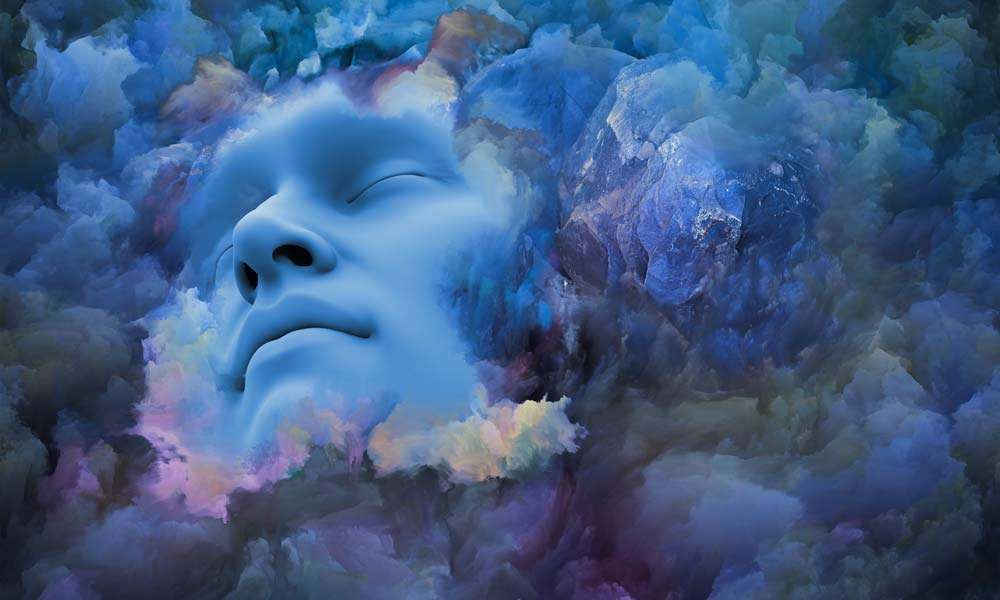Dreams Theory
Dreams and Evolution: The Theory of Dreams
Of course, when it comes to the evolutionary meaning and significance of dreams, attention turns directly to our close cousins and other animals in general. Nowadays, we are sure that other animals dream like us humans. To date, dream-like behavior has been observed in many mammals, from dolphins to armadillos, from opossums to monkeys, dogs, cats, mice, elephants and small rodents.
Pet owners have seen dogs trying to run while they sleep or cats acting like they're hunting for prey. Apart from this, dream-like behaviors have also been observed in birds and some reptiles. However, the problem remains the same: while even humans cannot provide accurate information, it would be pointless to expect to receive information from non-human animal species.
For this reason, unfortunately, we do not know at what stage of sleep non-human animals see their dreams, what the images look like, and what kind of scenarios they find themselves in. Despite this, behavioral scientists think that they can determine the effects of dreams based only on the behavior of animals. For example, an interesting study has shown that the dreams of species with more developed brains and perceptual abilities are more complex, their physiological effects are stronger, and their behavioral symptoms are more severe. Maybe for this reason, people attach excessive meanings to dreams.

To understand the cause of dreams, we need to remember a fact we mentioned at the beginning of my article: During sleep, the majority of the conscious and perceptual functions of the brain are reduced to a minimum level, if not completely turned off (this is why we can wake up in case of a sudden stimulus); However, the body continues to work to maintain its vitality, including the brain.
The only reason we can perceive nature is that our brain can evaluate the information coming from the sensory organs biochemically at the cellular level. During sleep, signal transmission from sensory organs continues, but the regions of the brain related to consciousness cannot process this at all, unlike during the day. However, during biochemical processes during sleep, some parts of the brain can stimulate other parts that are closed.
Many ideas have been put forward about why dreams occur; Some of them have been supported by many studies and enabled us to build a general theory. One of the most important studies on this subject is the Activation-Synthesis Hypothesis, put forward by John Allan Hobson and Robert McCarly, psychiatrists at Harvard University, in 1977. According to this hypothesis, dreams are the reactions of the forebrain to random signals produced by the brain stem during sleep. These random signals result from continued activity in the brain stem during sleep. This is also supported by the data from people with auto-activation disorder that I mentioned earlier.
According to the hypothesis, these electrochemical signals leaking through the gateways between brain regions are perceived as images in the forebrain; because the structure of biochemicals is such that it can be perceived by the cells here. While you are awake, these unwanted images do not occur because the intervening gates (relays) are actively working. However, when problems occur in these relays due to some diseases, damage or genetic reasons, dreams may also occur while awake (in this case, it is called delusion or dream). These findings cause the hypothesis to be considered a theory today; but research continues.
However, a study conducted in 2001 by William Domhoff from the University of California at Santa Cruz, which is at the forefront in the world with its brain and dream research, revealed that this hypothesis is not yet complete and has some shortcomings. According to the claim of the new theory, it is not possible for the random effects of chemicals secreted from the brain stem to ensure proper chronological order in dreams. The vast majority of dreams are abstract and surreal. Places, people and events change rapidly.
There is usually no chronological order, and this is where the previous hypothesis derives its strength. However, some of the dreams are quite systematic, they proceed in an orderly manner, the place and people do not change, and the flow of time is felt. Domhoff thought that such dreams should also be explainable. His work and that of some other scientists have shown that although the brainstem plays an important role in triggering dreams and gives rise to our complex dreams, the forebrain, which they believe is where dreams actually occur, can also initiate and sustain dream formation.

In this case, if we make a general analysis, we can say that the background of the formation of dreams is the involuntary stimulation of some brain regions during electrochemical activity during sleep. For example, some random images recalled from our memory appear before our eyes in a complex order during sleep. However, once these random sensory data are activated, the forebrain, which controls our more controlled behaviors, can take control.
In this case, dreams can leave a complex and chaotic plane and reach a plane that can be followed chronologically and even logically. Sometimes, the forebrain can work alone and include a highly logical sequence of images, sounds, smells, tastes and feelings in the dream, without any chaotic elements.
OK but why? Why do we need something like this? Why do we dream or have we experienced an evolutionary process that could enable us to dream? There are many more hypotheses and theories about how dreams occur than I have mentioned here; but none of these have yet reached a final and fully supported size. Nevertheless, the data obtained from each of them enable us to shed light on the evolutionary origins of dreams. Of course, we need to benefit from Evolutionary Biology in order to see the reasons why we dream.

In 1993, Winson conducted a study in which he claimed that REM sleep was found only in marsupials and placental mammals and had not evolved in any other animal group. Later research has shown that REM sleep evolved more than about 220 million years ago, before marsupials and placental mammals diverged. Later, this feature spread to both giant mammal groups and became visible in almost every member. As I explained at the beginning of our article, we call such features "synapomorphy", which evolved in a common ancestor and were passed on to all descendant species during the evolutionary process.
However, the different REM sleep physiologies between species show us that there have been natural selection effects on REM sleep throughout the evolution of these species. Some anthropologists think that the emergence of dreams for the first time with the evolution of REM sleep endangered the lives of living things. Because creatures that have very realistic dreams can put themselves in serious danger by acting in their dreams.
Therefore, it is thought that Natural Selection operates in a way that reduces the clarity and impact of dreams. This directly causes the dream physiology to change. Another group of scientists suggests that when dreams first occur, the brain shows unexpected activity as it thinks that the sleep state has been awakened, and therefore people experience sleep paralysis. For this reason, Natural Selection must have been applied to reduce the intensity of sleep.
In this case, dreams must also have an advantageous effect on living things, so that they can be preserved without extinction in the evolutionary process. In addition, the fact that a feature that is so widely found in the Animal Kingdom stems from a simple mistake and has not disappeared in many lineages until now suggests that dreams must provide a certain advantage. At this point, it is necessary to mention a very important and widely accepted dream theory developed by Antti Revonsuo, Katja Valli and their team: Threat Simulation (or Rehearsal) Theory.
As you can understand from their names, according to these theories, dreams are a rehearsal for events that may happen in real life. Therefore, the more the brain perceives dreams as real, the more events that may happen in reality are rehearsed and experience can be gained against unexpected situations without causing real damage. This theory derives its strength from the fact that the most remembered dreams are the ones that are the most stressful, contain the most negative emotions, and are based on the most dramatic conflicts. This suggests that dreams help us prepare for difficult traumas that may occur during the day.

- Dream experience is an organized and specifically selected simulation of our perceptual world. What we experience in our dreams are generally events and phenomena that we can experience in real life. Therefore, rather than being "random noises", dreams are sensory experiences selected from the real world.
- There is often a tendency towards negative and life-threatening elements in dreams. This enables us to respond appropriately to situations that are important for evolutionary adaptation. Since we do not have to actually confront the elements in our dreams while dreaming, we obtain a simulation-based experience.
- Especially in individuals going through difficult times, dreams are organized by the brain in a way that makes it easier to get through those difficult times. This situation varies depending on the biological organism's perception of threat and its tendency to escape from it.
- Although the dreams are a copy of reality, they also have an incredible realism. In this way, dreams can be seen as a real preparation process for situations that may actually happen to us. The most concrete data supporting this situation is that while we are dreaming, we sometimes physically perform movements that are exactly compatible with the dream.
- The perceptual and motor abilities that come into play during dreams enable the individual to actually develop these abilities. Thus, even if dreams are not remembered after waking up, dreams will be advantageous because the brain and body have that experience. Thus, implicit, procedural learning can occur.
- This Threat Simulation Mechanism has been selectively emerged during the evolutionary process because it is advantageous. Rather than being an inherent feature, it evolved due to the dangerous situations our species has experienced. This is supported by the fact that our ancestors lived through times when they were under great threat. This mechanism has increased our species' chances of survival.
The basic thing to know within this entire theory is that dreams, regardless of their content, offer living beings the chance to experience an unreal environment and thus increase their chances of survival and reproduction in real life. For example, our ancestors may first have had dreams about a threat originating from nature and thus gain experience before this threat materialized.
The issue that comes to mind here and that we encounter most frequently in popular science is whether the people and places we create in our dreams have to be people and places we have seen before. Allegedly, the brain cannot create new places and new people in dreams; It can only recall people and places that already exist in the cells of our memory. So, seeing unfamiliar faces in your dreams does not mean that you have not seen them before: walking on the street, on television, on billboards, etc. Every face we see, if it has even a small place in our memory, can be recalled and used in dreams.
We can say that this is largely speculation. There is not enough reason and scientific data for it to be right or wrong. Therefore, at this stage it should be seen as just an idea, a speculation. However, if true, this may provide additional data regarding the person's involvement in the events he is currently seeing in the dream. This would be a finding that supports the Threat Simulation Theory from another perspective. Of course, that's not to mention the difficulty of testing and supporting such a claim.
So, can we be sure that the view that "most dreams have negative content", from which this theory derives its strength, is true? In a study conducted by Hall and Van de Castle in 1966, the dream reports of 500 subjects were collected and evaluated. It has been observed that 80% of these dreams are dreams about negative emotions, which falls well beyond the limits of randomness.
In addition, in each of these negative dreams, without exception, threatening elements of different shapes and intensities were encountered. This experiment was repeated and confirmed by Jane Merritt and others in 1994. In other words, although dreams are triggered by random reasons, they do not occur randomly but in a way that will benefit the individual. This increases the evolutionary success of individuals and explains why we dream.
There is much more that can be said about dreams. For example, in the event called Lucid Dreaming, the person becomes aware that he is dreaming and can develop his dream in the direction he wishes. During this phenomenon, the body is in a dormant state; However, the brain is not fully asleep. This ability may have been made possible during the evolutionary process and is mainly due to the brain waves being between wakefulness and sleep, and the brain transitioning from a sleep state to a semi-functional state. As demonstrated by Stephen LaBerge in 1980, while very few people in the population naturally possess this ability, it can also be learned through study.

These techniques involve stimulating the human brain with various physical methods while falling asleep and telling the brain, "You are sleeping; be aware of it." It is about ensuring that the information is learned by the person. In daily life, a person trains his brain for an action that he associates with "remembering that he is awake." For example, during the day, at certain intervals, he snaps his fingers or pinches a certain point on his leg while saying, "You are awake now, be aware of this." He practices mentally in the form of.
After long-term studies, the brain becomes conditioned to this physical movement (finger snapping or pinching), and even if the individual does not repeat it, the brain is warned that he is "awake" as soon as this movement is made. Then, the phenomenon of falling asleep is modeled with some meditation and relaxation techniques and is learned thoroughly by the person. Then, after many years of practice, the person conditions himself to perform this learned and conditioned physical movement while falling asleep, and the brain is stimulated before falling asleep, and even though most of the body and brain fall asleep, the person convinces himself that he is awake and remains awake.
In this way, he can control his dream from the moment he enters REM and the dream begins; because by actively using his brain, he can stimulate the images formed in the forebrain. So much so that, in studies conducted on people with this ability, people were asked how many times in total they entered REM during sleep, and the exact number of REM times the person actually entered was known with 100% success. This practice may cause fatigue in the person because it does not allow proper and healthy sleep.

Source
https://www.mayoclinic.org/diseases-conditions/rem-sleep-behavior-disorder/symptoms-causes/syc-20352920#:~:text=Symptoms%20of%20REM%20sleep%20behavior,emotional%20outcries%20or%20even%20cursing
https://study.com/learn/lesson/forebrain-function-structure.html#:~:text=The%20forebrain%20is%20responsible%20for%20voluntary%20actions%2C%20thinking%2C%20and%20processing,white%20matter%20and%20gray%20matter.
https://en.wikipedia.org/wiki/Apomorphy_and_synapomorphy
https://my.clevelandclinic.org/health/body/12148-sleep-basics#:~:text=What%20is%20REM%20sleep%3F,activity%20while%20you're%20awake.
https://en.wikipedia.org/wiki/Antti_Revonsuo
https://pubmed.ncbi.nlm.nih.gov/15766897/#:~:text=Abstract,to%20repeatedly%20simulate%20threatening%20events.











































































